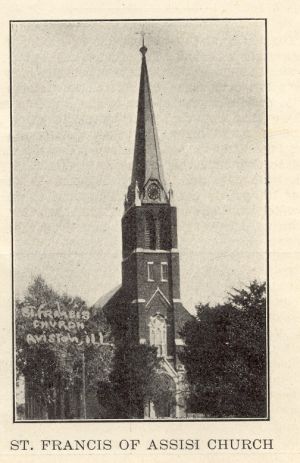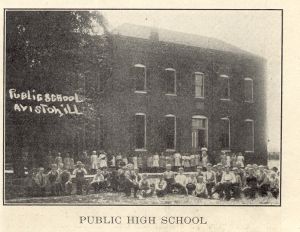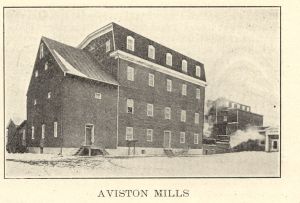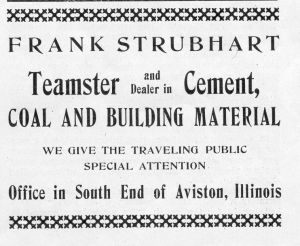Page 8 | |
|
Aviston, one of the smaller towns of Clinton County, Ill., has very little stirring history to chronicle. Established as a school district in 1825, on petition presented by several influential citizens of Sugar Creek District, the nucleus for the present little village was laid. Immediately after granting of the prayer of petitioners a public school was erected, the district being designated as Mount Pleasant School District. Later on this very pretty title was changed to prosaic numerals, the district now being known as District No. 2, Township No. 2. The history of Aviston is so closely bound up with the history of its school that to speak of the growth of the former necessitates reference to the latter. During the perilous days of the Civil War, several intrepid and staunch Catholic settlers organized St. Francis Assisi Congregation at Hull, now Aviston. Shortly thereafter a brick school house was built by this congregation, and it became the educational center of this little city. So excellent was this school from the very first that it continued the principal school in Aviston up to this day. Its principal is Mr. Henry GRAMMAN, the Nestor of Clinton pedagogues. He has been actively engaged at this school for thirty-one years. Being a village of beautiful homes its pastoral quiet has never been broken by the hum of industry; only one or two large manufacturing concerns being located within its borders. Among these are the Aviston Milling Company plant and the Aviston Creamery, both of which will be more fully described. The neighborhood of Aviston is settled by well-to-do farmers. Most of these are of German descent, noted for their splendid abilities as grain raisers, many of them averaging from 35 to 40 bushels of wheat to each acre of land sowed to this productive cereal. Besides being large raisers of wheat many are dairy farmers, owning all the way from 10 to 30 milk cows each. Aviston proper was laid out in 1860 by J. W. DUGGER and Company. It is situated on the Baltimore and Ohio Southwestern R.R. Mr. DUGGER built the first substantial brick business house and in 1861 opened a general store therein. He likewise built the depot, its cost of erection being defrayed from monies subscribed by a |
number of progressive citizens, who saw in the building of a suitable depot the rapid development of their primitive village. St. Francis of Assisi Church The village of Aviston, Illinois, and the surrounding settlement was first called Hull. The name Aviston is taken from the Post Office. The first Catholic settlers were Berand HULESMANN, 1839; Diederich OVERBECK, 1841; Herman Heinrich MARKUS and Gerhard FELDMAN, 1848; Bernard WEMPE, Heinrich SCHALLENKAMP, Bernard KNUEVE, Heinrich MERSCHER, Heinrich STROOT, Carl STUEVER, etc, 1849. Rev. Henry BOEKER was the first resident pastor at Aviston. He arrived October 2nd, 1865 and died here January 18th, 1875. On November 23rd, 1874, Rev. Longinus nus QUITTER was sent to act as assistant priest; he left Aviston September 8th, 1875. The present pastor, Rev. Frederich LOHMANN, arrived March 23rd, 1876. The extent of
the parish was four miles north, two miles east, two and one-half miles south, and one mile west. The first church was 82X54 feet, without a steeple, and was a brick building; had a seating capacity of 420 persons. The members of the congregation, without the |
|
Page 9 |
|
|
assistance of a priest, built it in 1864 and 1865 on lots No. 2 and 3 of block No. 28 in Aviston, at a cost of $11,741.00. For vestments and other things necessary for the divine service, the people offered October 4th, 1865, $1,678.25 in 1866, a high altar at a cost of $500.00, and a pipe organ for $1,600.00 were installed. A new brick church 14X58 feet, with a transept of 78 feet on the east end, and a tower of 185 feet on the west front was commenced by Rev. F. LOHMANN, on lots two, three and four of bock 28, in the year 1886, and was completed in 1887. It has a seating capacity of about 820 persons, and cost $42,000.00. The cost of a statue of St. Francis of Assisi, 7 feet high, of Indiana stone, on the portal in front of the tower $150.00; for a chime of four bells "B flat," $2,639.00; for repairing the organ and two additional registers, $420.00; for the stations of the cross, five new altars, a pulpit, seven statues, a steam heating plant, a tower clock, and new seats, $7,000.00. October 26th, 1892, the church was consecrated by the Rt. Rev. J. JANSSEN, Bishop of Belleville, Illinois. In 1909 the parish was raised to the rank of an irremovable rectorship. The first and present rectory, a two-story brick building 38X32 feet with eight rooms, was built by Rev. H. BOEKER in 1866 on lot 9 in block 28, at a cost of $2,571.00. The first school a one-story brick building 38X30 feet, was erected by the Rev. H. BOEKER in 1887, on lot 2, block 21, and cost $1,395.00. In 1874 an addition 20X20 feet was added and cost $617.00. In 1879 the old school was taken down by the Rev. F. LOHMANN and a new two-story structure erected, 54X52 feet, with a seating capacity of 210 children, at a cost of $3,500.00. A brick house 32X30 feet, for the residence of a teacher, was built in 1867 by the Rev. H. BOEKER on lot 8 in block 21, which cost $1,531.00. The Sacred Heart Hospital, a two-story frame structure, on lots 6 and 7, in block 22, was finished by Rev. F. LOHMANN in 1862 at a cost of $6,524.00. The hospital is in the care of the Sisters of the Poor Handmaids of Jesus Christ, and has 22 beds. There are four societies in the parish: The St. Francis Menís Society, with 80; the St. Aloysius Young Menís Society, with 68: the St. Anna Ladiesí Society, of 113, and the Young Ladies Society with 70 members. The St. Francis male choir has 20 members. The parish has about 185 families, or 950 souls: all are of German descent, except two. The growth of the parish is steady and normal. Three of our boys have become priests and eight girls sisters. Exceptional benefactors of the congregation were Henry WAGEMELER, Diedrich OVERBECK, Henry MARKUS, Gerhard FELDMANN, Henry NETTEMEIER, Mrs. Angela STROOT, Mrs. Elizabeth HEIMANN, etc. In 1864 a square piece of ground of five acres was bought of Samuel HULL for a cemetery at a cost of $210.00. Previous to this time interments of the Catholic settlers were made in the cemetery at Germantown. Rev. Frederick LOHMANN, the present pastor of the St. Francis Church at Aviston, was born at Drensteinfurt in Wesphalia, April 24th, 1842, graduated "cum laude" at the Gymnasium of Recklinghausen; studied philosophy and theology at the University of Muenster, entered the American College and was ordained priest Mary 8th, 1869. Was appointed assistant priest at the Cathedral in Alton, Illinois. In 1871 was sent as pastor to Hillsboro, Illlinois, and on the 23rd day of March, 1876, was transferred to Aviston, Illinois where he has been ever since. Prof. Henry GRAMANN We have already mentioned the fact that Mr. Henry GRAMANN, the efficient principal of the Aviston school as |
also organist of St. Francis Congregation is the Nestor of the teaching fraternity of Clinton County. He is a child of Germantown parish, having been born there on March 15th, 1857, and is of German-Dutch parentage. After having graduated from the elementary and advanced schools he was sent to Quincy, Ill., in 1873 and place under the private tutorship of Rev. Fr. BRUENER, and teacher, Wm. HECKENKAMP, Sr., of St. Maryís church, that city. Later on, in 1874 and 1875, he attended the Catholic Normal school at St. Francis, Wis., of which Rev. Fr. BRUENER became rector. After his graduation from this excellent
In 1878 Mr. GRAMANN married Miss Theresia SCHEPPERLE of Highland, Ill., which union was blessed with a number of sturdy sons and winsome daughters. Mr. GRAMANN is at present active in Catholic society circles in Clinton County and for a time was Secretary of the Illinois Staats-Verband, a federation of German Catholic societies numbering above twenty-three thousand members. Ben HOLTKAMP The above named is a native of Germany, having come to this country with this parents when seven years of age. After their arrival they settled on a farm near Aviston. After working at Breese, Ill., and St. Louis, Mo., for some time he returned to Aviston at the age of twenty-two and embarked in the threshing business with his brother, Henry HOLTKAMP, and Henry GROEHNE.
In 1893 the subject of our sketch acquired the interest of his partners and with John SCHULTE, started a saw mill and also continued his rapidly growing threshing business. Another change was made in 1907 when Mr. SCHULTE conducted the threshing industry while Mr. HOLTKAMP |
|
Page 10 |
|
|
operated the saw mill. At this mill is manufactured sawed lumber. In addition, Mr. HOLTKAMP operates a grist mill, grinding corn meal and ground feed. He also runs a cider mill and a molasses mill. A special brand of picket fence is also manufactured. The products of these mills is largely disposed of to home trade. He also operates an aviary, having fifty stands of bees, which produce annually about 2,500 pounds of comb honey which is largely shipped to East St. Louis, Ill., for sale. Mr. HOLTKAMP has a beautiful residence adjoining the mill property in which he and his estimable family reside. He was married October 30th, 1888, to Caroline FOPPE, of Germantown, which union was blessed with seven children, five boys and two girls, all of whom are still living with their parents. LAMPE Brothers The firm of LAMPE Brothers has been in existence for the past sixty years. Six years ago the present firm bought out the interests of Hy. FICKER. They are dealers in farming implements of all kinds and do general blacksmithing and horseshoeing, and also repairing. The members of the firm are John A., Henry R., and Henry Marcus. Each take an active interest in the management of the business. John A. is president of the Village Board, or Mayor of Aviston. He has filled that office for three years. He was elected in 1911, having been appointed to fill a vacancy in 1910. The firm handles hardware, paints, oils, glass, steam fitting, piping, tanks, farm machinery and do plumbing guttering and carpentering. They have erected fourteen houses with the city during the past four years. All the boys were born in Aviston. John A. was born in 1880 and was married in 1905 to Ann KENSCHEN. The couple have five children, all of whom are living. The shop of this firm is located several blocks south on the depot, within walking distance of the business district. The Tavern The Tavern is the name of the one hotel of Aviston. It is owned and managed by Mrs. H. G. SCHULTE. She has been conducting the business for the past six years, having bought out Coon BACH. The hotel contains ten rooms and the rates are $1.50 per day, and well worth it, for the meals are as good as can be found any where in the state for the price. A saloon adjoining is also owned by Mrs. SCHULTE, and all the leading brands of bottled beers, wines, liquors and cigars are sold. Mrs. SCHULTE was born in St. Louis and was married in 1889. Her husband died several years ago and she went into business for herself immediately after his death. She has two children, both grown, a son and a daughter. |
Aviston Flour Mill This article was complied from notes of Rev. F. LOHMANN, Pastor, St. Francis Church, Aviston, Ill. The Ohio & Mississippi R.R. (now Baltimore & Ohio Southwester R.R.) was the first railroad to build through Clinton County. The people at Damiansville, a village 7 miles from Aviston, (formerly Hull), received their mail from Aviston, as also their freight and express. The farm products
from Damiansville and the country tributary to Aviston had to be shipped from the last named place. Thirty to fifty years ago the main product for shipment was wheat. In consequence of this a few wealthy and energetic farmers decided to build a flour mill in Aviston. Messrs. J. B. HEIMANN, who still lives with his wife in Damiansville; his brother, B. H. HEIMANN, and Albert HAAR, started the building of the mill in 1867. The mill was completed in 1869, but on account of the milling business being a very unsafe one in those days, since all products were sold through commission houses, the original owners of the mill, shortly after starting it, sold out their interests to Messrs. Hy. DILLMAN and Hy. DULLE. Mr. Theo. PEEK moved to Aviston in 1868 and joined Mr. DILLMAN, both in the lumber business and in the milling business. In 1870 Mr. Hy. ROBBEN bought out Mr. DILLMAN and invested about $11,000.00 in the business. Messrs. DULLE and ROBBEN then operated the mill from 1870 to 1879. In the fall of 1876 an explosion of the boiler cost the company quite a loss, in fact, the entire boiler house was destroyed, only the chimney was left standing. No one was killed, however, and Messrs. DULLE and ROBBEN made repairs and continued to run the business until 1879, when they sold out to MAUNTEL & BORGES Co. Mr. MAUNTEL, the president, and his two sons, John MAUNTEL, secretary, and Bernard MAUNTEL, manager, made some very extensive improvements. A second story was built the old machinery was taken out and replaced by modern machinery. In 1881 a new elevator was built with a capacity for storing 75,000 bushels of wheat. A dwelling house was built for the manager and two houses for the millers. Side track was laid, the mill pond made larger and deeper, a larger cooper shop erected, and finally a warehouse. The company went along very nice until Mr. DIEKMAN was brought into the company and made secretary. One day Mr. DIEKMAN left for Canada and shortly thereafter the firm was declared bankrupt. Creditors gave Mr. John MAUNTEL time to settle his liabilities and Mr. O. L. BRYAN, known by every one as Dick BRYAN, was appointed to take care of the property. He bought wheat, corn and oats and did a very successful business. Finally the property was sold at public sale in Carlyle, August, 1893, to Mr. Aug. SCHLAFLY. Mr. SCHLAFLY formed |
|
Page 11 |
|
|
a new company under the name of Aviston Milling Co., with the following as stockholders: Mr. Aug. SCHLAFLY, president; Fredolin SCHLAFLY, vice-president; Hy. LAUX and B. H. HEIMANN, secretary and treasurer. In 1889 the corn elevator owned by Mr. Geo. KNIEPMAN, and standing near the present stock pen was purchased, and moved to the north east side of the mill. In October, 1909, Mr. Paul C. GUIGNON succeeded Mr. HEIMANN as secretary and treasurer. In 1910 a brick office was built on the south side of the elevator and considerable money has been spent in the last three years in machinery, enabling the mill to turn out as high grade flour as any of its competitors. Almost all the flour is shipped into the Southern states, whereas most of the feed is disposed of at the mill door and in the vicinity of the mill. Occasionally flour is shipped to Europe. The present officers of the company are: Mr. Aug. SCHLAFLY, president; Mr. Fredolin SCHLAFLY, vice-president, and Paul C. GUIGNON, secretary and treasurer. SOIL FERTILITY INSPECTION TRIP. A party of one hundred and five people, including students from Doctor Hopkins' class in Soil Fertility, College of Agriculture, University of Illinois, members of the faculty, and members of the Advisory Committees of the College of Agriculture made a trip of inspection to Southern Illinois on June 5 and 6. The party reached the farm of Doctor Hopkins at Tonti on Friday morning at 6:00. After visiting the various fields the entire party was served with breakfast at the farm. The application for this farm is first, ground limestone, then rock phosphate with decaying organic matter. The cost of this application on this farm for the past nine years has been $1.70 per annum per acre. The class saw a piece of land which had been purchased ten years ago for $15.00. It had been abandoned three years at that time. Today it has a crop of wheat standing as high as a man's shoulder, and the crop is estimated at 30 bushels per acre. After visiting this farm the party took the train and went to Odin, where they visited the State Experimental Plots. These plots demonstrate the need of limestone in the growth of clover; plots receiving limestone were making good growth of clover, while plots receiving no treatment had no clover and luxuriant growth of weeds. Leaving Odin they went to Lebanon, took dinner at McKendree College. After dinner they visited the plots of the Experiment Station. The party then returned to Odin and thence back to Champaign, reaching home early Saturday morning. WORK FOR THE UNIVERSITY OF ILLINOIS GRADUATES - ENGINEERS IN DEMAND. Of the one hundred and seventy-nine graduates of the College of Engineering, all but about ten had signed contracts with various companies months before the date of graduation for work in their chosen line, the salaries ranging from sixty to eighty dollars per month. ē The demand for mechanical, electrical and railway engineers has been excessive. Fourteen large companies, such as the American Locomotive Works, the Peerless Motor Car Co., the Bell Telephone Company, General Electric Co., sent representatives to the University during the last months of the school year to secure graduates for the apprentice courses in their works. These apprentice courses fitting them for sales managers, shop managers, special designers, etc. Many more companies have written to the college with the same request. It seems from the unusual demand for engineering graduates this year that college men are just beginning to rise in greater- number to the control of the larger companies, |
corporations, etc., and are filling even the subordinate positions with college men, offering special inducements in courses of instruction fitting them for higher and larger responsibilities. WILL COMPETE WITH U. S. Italy is now a competitor with this country in the production of lemons, dates, olives, oranges,. figs and other fruits of the semi-tropical class. Italy expects to become even a greater competitor in these fruits as a result of having annexed Tripoli, which the Foreign Office reports produces along the sea "palm, olive, lemon and fruit trees" The second zone grows "olive, palm and fig trees, cereals and saffron." The third zone consists of oases, rich in palms. The fourth zone "is covered with palms, figs, vines and almonds." Cattle could be bred on a vast scale in Cyrenaica; bananas are grown at Derna. In Tripolitania cotton, tobacco, castor beans, saffron, indicus, and henna are grown, ninety million pounds of esparto are exported, and Prof. Borzi advises the cultivation of cotton, sisal. vines, olives, mulberries and almonds. AGRICULTURAL GRADUATES. In regard to these we repeat what was given in a Special Bulletin : "The College of Agriculture is graduating an ever increasing number of men. The larger percentage of these graduates are now engaged in practical agriculture. This is shown by statistics being gathered at the present time. Out of ninety-three men graduating this year, forty-four expect to go into actual farming operations; ten into experimental work at the University of Illinois; ten expect to teach; eleven will do graduate work; five are going to work for large implement companies, and the rest will be employed in work more or less connected with agriculture." PROFESSOR DETLEFSEN TO GO ABROAD. Professor John Detlefsen, Assistant Professor of Genetics of the University of Illinois, will sail June 17 from New York City for an extended trip through Germany, Austria, France and England. Professor Detlefsen will visit the principal genetic laboratories and experts of the above named countries, and will return October first. SALE OF WOOL Charles Roundtree, of Crawfordsville, Indiana, has purchased the wool from the flock of sheep belonging to the University of Illinois. The prices received were: twentyone cents per pound, delivered, for the Down wools, and nineteen cents per pound, delivered, for the fine wools.
|






